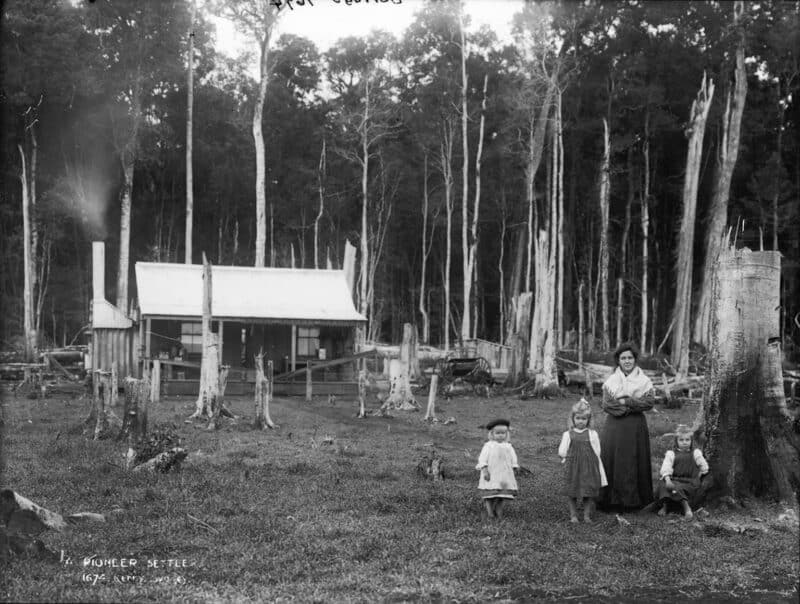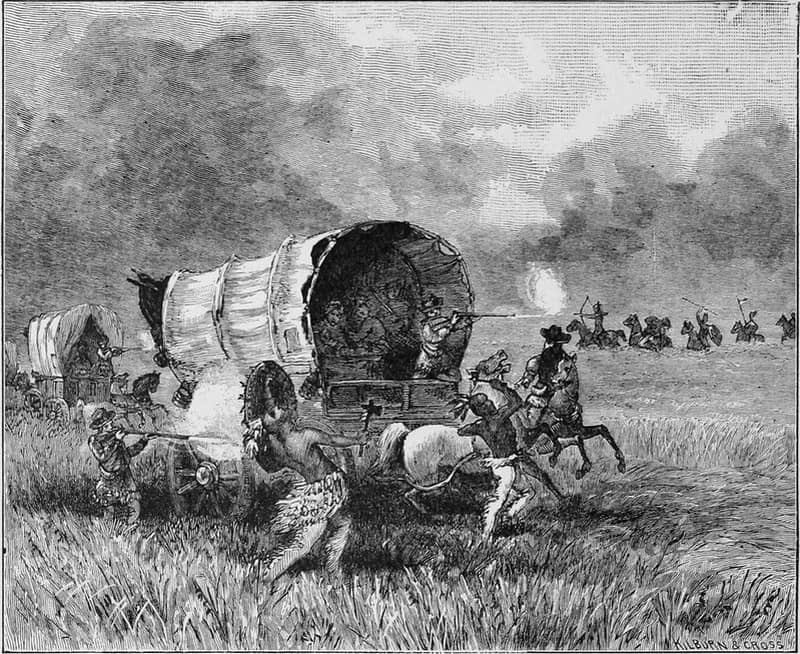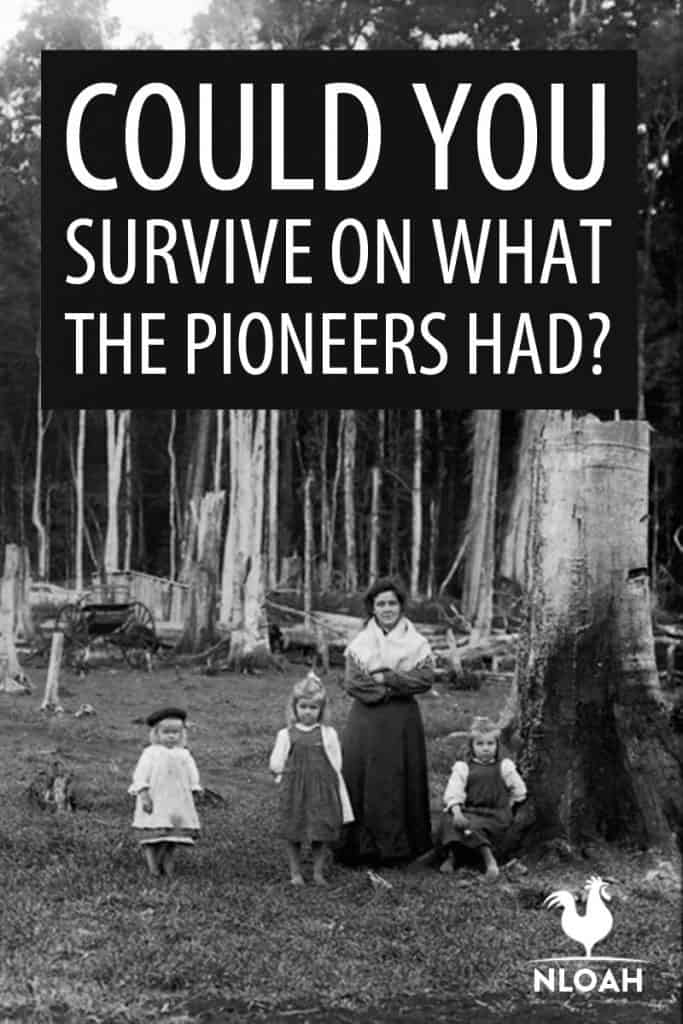My grandmother was always quoting this quote: “Use it up, wear it out, make it do or do without”. While I’m not really sure of the exact origin of that quote, I’ve heard it many times, especially from my family and homesteading friends.

I’ve found the saying to be very true. If I don’t use it up or wear it out, I will find a way to make do, or I’ll do without until I can figure something out.
The pioneers were faced with many challenges. They left their comfortable homes back east and trekked their way across the prairies and mountains in search of a better life. They set out with high hopes and dreams. At the beginning of their journey’s many were so excited that they could hardly stand it.
Many sought land and a few were headed for gold mines. All of them had one thing in common, they had only what they could bring with them. As a homesteader, we too started out full of hopes and dreams.
Boy, were we in for an awakening. Don’t get me wrong now, we’re enjoying our journey. And just like any journey, there are days where we wonder “what were we thinking”?
Homesteading often reminds me of the pioneers. In an effort to save money, we often find ourselves surviving on what we have. We use terms such as a simple life, less is more, and other such terms that denote our mindset of self-sufficiency and the attitude of saving money.
The pioneers had precious little when it came to money. Even when considering that wages were far less back then than they are today, many of them set out in search of work to help support their families.
In short, we have learned to live with what we have. When considering what we have, I stopped and pondered what the pioneers had. In all honesty, my research shows that they had precious little.
If they didn’t bring it with them, they either made do with what they had, made what they needed, or found something that could serve for dual purposes. Could you survive on what the pioneers had? Here is a fairly close comparison to help you decide the answer to the question.
Food Supply
Pioneers who were going across the country would pack up all of the food supplies that they could find. This would include such things as coffee and tea, flour, sugar, beans, and many would even carry a yeast starter or sourdough with them for making bread along the way.
The rest of their food supply was gathered along the way. It included berries, fruits that were foraged, wild roots and vegetables as well as game that was hunted enroute.
It may have also included dried meats like jerky or pemmican. They ate a lot of “Chuck Wagon Beans” and jerky gravy. They focused on comfort foods that were very filling.
Today’s modern homesteaders typically raise their own fruits, vegetables, and meats. Many homesteaders started out on a “beans and rice” diet. Truthfully, you can do a lot with beans and rice. Homesteaders work hard to keep food on the table and ensure that their families have plenty to eat.
Homesteaders focus on food storage and growing as much of their own food as they can. With a focus on self-sufficiency homesteaders today are often pioneers in their own way.
With root cellars and canning methods they often store foods for long periods of time. Many also smoke their meats, dehydrate foods and even freeze foods in an effort to help preserve foods for as long as possible.
Gardens
Once pioneers were settled they often planted a small garden. Even if they only gardened a few herbs this helped them to build up a small food supply. They learned to save the seeds for next years planting. Gardens often started out small but would grow the longer that the pioneers lived in an area.
As a homesteader, many of us have envisioned a gorgeous luxurious garden resplendent with a wide array of food. Of course, all of this will take some time. Homesteaders rely heavily upon a vegetable garden for food.
They save seeds, plant larger gardens the following year and slowly grow their garden space. It’s not unusual for a homesteader to have a small orchard, a berry patch, and a vegetable plot to help supply their food.
Orchards
Some pioneers had fruit trees and a small orchard or access to such an area. Great care was taken to ensure that these trees were well cared for in order to provide some fruit to the family.
Not all homesteads have fruit trees or an orchard. For those that do, it’s important to remember that if you’re planting fruit trees or an orchard, you’ll want to remember that the trees won’t produce fruit for anywhere from three to five years.
If you’re planning on an orchard, make sure that you get the trees planted as one of the first tasks that you do when you’re establishing your homestead.
Water
Without a water supply pioneers wouldn’t have survived. While they couldn’t necessarily carry enough water for the entire trip, they followed trails that allowed them to refill their water containers.
They used barrels, skins, and other means to contain water while they were in transit. On their homesteads, they dug wells or utilized springs to supply the water that they would require. In this fashion they usually had a steady water supply.
By the same token, as a homesteader, we have a steady water supply. We have 2 wells on our property. One is fairly shallow at 15 feet and the other is deeper. We also have a spring that feeds a small pond on our property so we have a great water supply.
I once lived on a homestead where I had to haul water from another homesteaders property to a holding tank on our property. Our spring only had water during the spring and summer months so we had to plan ahead. Thankfully, we were able to barter some of our gardening area to our neighboring homestead friends.
Shelter
The pioneers often traveled in covered wagons. They sheltered in their covered wagons or sometimes in tents, or even the woods if necessary. Many of the men slept out by the campfire.
Upon arrival to their new property or location they had some form of shelter in mind that they utilized until they could build their homestead or cabin.
Today’s modern homesteaders often start out in a simple shelter. They may build a simple cabin, or they may stay in a camper or even a tent during the warmer months.
Regardless, shelter is a must have for survival. If there aren’t any buildings on the property when it’s purchased, they will create some form of shelter for survival.
Staying Warm
The pioneers stayed warm by wearing layers. They had campfires on the trail and they had fireplaces in their homes. They usually only had one or two windows and relied on holding the heat in with chinking or mud. Homes in the pioneer days weren’t warm at all.
Our first homestead had paper thin walls and the insulation had long ago disintegrated. We learned to dress in layers. We used our woodstove and we had a few throw rugs that were strategically placed over cold floors. We also blocked windows with heavy blankets and pushed towels or blankets underneath of drafty doors.
Animals
Pioneers who were able to afford a cow that was able to be milked had plenty of milk, butter, and cheese to eat. When the calves were born they could also raise them for meat.
In addition, the cows would help to “mow” the prairie down. Not all pioneers were able to afford livestock. Many of them would go in together and share in such a purchase.
As a homesteader, our goats offer us plenty of milk, we can make goats milk soap, cheese, drink the milk and use it in baking. Our other animals offer us eggs and the occasional chicken dinner. We also have a few other options on our homestead.
Pioneers were resourceful when it came to raising their own meat and as homesteaders, so are we. It’s long been said to “not put all of your eggs into one basket” so we’ve made sure to diversify and have a variety of options for our homesteading animals.
Tracking Game
Pioneer men often went out hunting and would come back with deer, squirrel, opossum, and other types of meat. There were also those who would find elk and moose.
Nothing was left to waste and pioneers found a variety of ways to preserve the meat and use even the bones (have you ever seen antler buttons or bone buttons?). Bones were cooked into soups and stews and all of the meat would be cooked off of the bones prior to discarding them.
The men and older girls on our homestead often go hunting for deer and elk. We have taught the older ones how to track wild game and they all know how to scout them out.
We usually have two or three deer that we add to our food supply annually. We make jerky, steak, ribs and more out of this and store them either in the freezer, by canning, or by making jerky in our dehydrator or smoker.
We cook the bones down to nothing and use the bone broth to rejuvenate our immune systems. We can the extra bone broth and use it in soup bases.
Predators
There were a wide variety of predators that could cause the pioneers grief. From marauders to wild animals, snakes, and more there were many ways that a pioneer could lose their life. They had to learn to be vigilant and watchful in everything that they did.
Homesteaders also face many predators. From raccoons attacking the chickens to foxes, coyotes, wolves, bears, occasional snakes, and even cougars, there are many ways that predators can wreck havoc on a homestead.
It pays to be mindful and keep a close eye on the homestead. Good fencing and a watchful eye can go far in preventing predators from wiping out that flock of chickens or the newborn lamb among other things.

Fishing
Pioneers didn’t have access to the types of fishing tackle that we have today. However, they would make do with what they had and find ways to catch fish.
Whether they learned from the Native American’s and speared the fish, or trapped them, or they threw a line into the water, they would fish to help supply their food stocks.
They often had fresh fish if they were near a body of water. If they weren’t near a body of water they may smoke the fish and transport it wrapped carefully to preserve the quality.
Our homestead is located near a great fishing area and we often spend an early morning or late evening casting our fishing lines into the water. The kids enjoy fishing and it’s a great time to spend some family time.
As a kid, I thought fishing was a fun activity with my dad, little did I know if we didn’t catch any fish that day, we didn’t eat dinner. Today, we clean our fish and either freeze it, can it, or put it into our smoker. It’s a great addition to our pantry.
Medical Supplies
The medical supplies of the pioneers would have been very rudimentary compared to what we have on hand today. However, they would’ve made do with what they had and used wood for splints and crutches and teas or herbs for medicinal purposes. It wasn’t unusual for whiskey to be used as an anesthetic.
Today, on our modern homestead, we have modern medicine. We have antibiotics, emergency services, and a basic first aid kit that would rival anything that the pioneers had for medical supplies.
We have the ability to diagnose and seek medical attention for a variety of ailments. Many pioneers didn’t survive medical emergencies that we often consider minor today. Thanks to modern medical practices and hygiene, we’re much healthier than many of the pioneers were.
Electricity
Of course, the pioneers didn’t have electricity. They had to make do with a warm fire, plenty of warm clothes, blankets and so on. Often, rocks or bricks (if they had any) would be heated and placed in the wagon or bed to help warm them.
Torches, lanterns or candles were frequently used (sometimes with disastrous results). While every effort was made to travel on the wagon trains during the daylight as well as the spring and summer months, a few did find themselves stranded in the colder time of the year.
It was very unsafe to travel after dark and more than one wagon train had to hunker down for an early winter to save as many of the party as they could. They learned a variety of methods to survive without electricity, heat, or life as we know it today.
Today, we often take electricity for granted. There have been a few times on the homestead when we’ve been without electricity. Staying warm can be a quick challenge, especially in the winter months.
We have focused on a “warm room” where we close off other areas of the house. We hang blankets over closed doors to help retain the heat in one room of our homestead.
We use our woodstove and if the power does go out, we will stock in extra wood so that we don’t have to continue opening the door and letting all of the heat out.
All of these things done together work well to help us should the power go out. We have plenty of oil lamps to help light our home (with all safety measures being followed carefully) as well.
When considering whether or not we could survive on what the pioneers survived on, I’m reminded that there are many things that we, as homesteaders, have in common with the pioneers.
Many of us have started out with just what we could carry to our homesteads just as the pioneers started out with just what they could carry on their journey. We’ve had to make do with what we have and work hard to save our money so that we could have the homestead of our dreams.
We, just like the pioneers, started out with high hopes and occasionally we’ve had them dashed to the ground due to circumstances beyond our control.
We’ve learned to adapt and roll with it and if something doesn’t go our way, we find another way to accomplish our goals. We’ve have had tough years where crops failed or animals died. We’ve had fires and droughts and floods.
There is nothing that we’ve gone through that the pioneers didn’t struggle through at some point in time.
We rely on our homesteads for food just as the pioneers relied on what they could find along the trail. We farm our own fruits and vegetables and just like the pioneers of yesteryear, we love our farm raised beef, pork, chicken, rabbits, goat and fresh eggs and milk. We also hunt and fish to help supplement our diets.
Pioneers also knew how to preserve their foods either by drying, dehydrating, or storing them in cold storage. Today, we use root cellars, canning, dehydrating and freezing as methods to preserve our foods.
We also make jams, jellies, preserves, butters, and dried fruits for the colder winter months. It’s a great way to round out our food supply. Just as the pioneers made their own bread, we often make our own bread as well.
We focus on wholesome foods that are filling and comforting. I suppose in a way, we could survive on what the pioneers had. Do you think you could survive on what the pioneers had?


Hi, I’m Linda. I’m a mom, grandmother, homesteader. I love simple living and enjoy my life on a homestead where I garden, raise a variety of animals and strive for a life more like my grandparents lived.
My goal is to enrich life by living it as simply as possible and focusing on the way my grandparents did things. Life is so much more fun when it’s lived simply.

I know I can and want to but finding a piece of property I can afford and getting started is the hard part I don’t know how to go about getting started or how to get the land to live like that.
I think I could. Don’t want to have to, but I think we could. I have already survived much in my 68 years. I’ve never been a “city” girl. Country all the way. I grew up shelling peas, snapping beans and picking these and many more things. We lived with my grandparents. They put up almost all of their food stuff. Either by canning or freezing. Those were happy times that I remember. I think they bought what they picked, as they didn’t have a garden. I grew up eating meat at breakfast and only once a week for dinner. We’d have some kind of beans or peas, potatoes, cornbread, and iced tea, milk or water. The best of times!
This shows how hard and hardy our ancestors where. Make a person appreciate the jump start we have today, “living off the land”!
Thanks for a great read!
Linda, I am living as my great grandmother and grandma did. Last year’s garden was a bust but the year before we were blessed. So now we are praying for a good garden and orchard this year because we’ll have to resort to buying what we need.
My great,great grandfather Zachariah was coming up to the Midwest from Texas in a covered wagon. And one day when they when they were traveling and it was starting to get to dark to see, the cow broke loose from the back of the wagon. They had stop immediately to wait until daylight to try and find the cow. At dawn they saw that they were sitting on the edge of a cliff. The cow could see it and that’s why it broke loose from its tether. So I am here today because of a cow.
😮